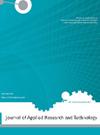Synthesis and characterization of Mo-blue-based sulfided CoMo catalysts for guaiacol HDO
Q3 Engineering
Journal of Applied Research and Technology
Pub Date : 2022-07-01
DOI:10.22201/icat.24486736e.2022.20.3.1064
引用次数: 0
Abstract
Saccharose (SA) and citric acid (CA) were used as additives in P-doped CoMo/Al2O3 catalysts (Mo, Co and P at 12, 3, and 1.6 wt%, respectively) intended to be applied in guaiacol hydrodeoxygenation (HDO). One-pot impregnating solutions were prepared by MoO3 digestion in aqueous H3PO4, followed by C4H6CoO4•4H2O addition. Organics were added (SA/Co=1, CA/Co=2) at two different preparation stages to assess the effect of that step on catalysts properties. Method I: SA or CA was added in as-prepared Co-Mo-P impregnating solution, followed by pore-filling impregnation of alumina support. Method II: SA or CA at aforementioned concentrations was impregnated on the pristine carrier, followed by drying (120 °C, 2 h). Co-Mo-P phases were further deposited on modified supports through corresponding one-pot solutions. All materials were dried (120 °C) but not calcined. Cobalt complexation by CA and Mo-blue LMCT complex formation (SA-modified solids) were identified (UV-vis, oxidic samples). Partially reduced molybdenum (Mo6+ => Mo5+, by XPS) was observed after either organics addition that effect being more evident in SA-modified solids. Materials were gas-phase sulphided (H2S/H2 10%, 400 °C, 2 h) then studied by HR-TEM. Co-Mo-P phases impregnation in one-pot solution simultaneously deposited with SA rendered the materials of the highest MoS2 dispersion.愈创木酚HDO mo -蓝基硫化CoMo催化剂的合成与表征
将糖(SA)和柠檬酸(CA)作为P掺杂的CoMo/Al2O3催化剂(Mo、Co和P分别为12%、3%和1.6% wt%)的添加剂,用于愈创木酚加氢脱氧(HDO)。在H3PO4水溶液中先溶出MoO3,再加入C4H6CoO4•4H2O制备一锅浸渍溶液。在两个不同的制备阶段添加有机物(SA/Co=1, CA/Co=2),以评估该步骤对催化剂性能的影响。方法一:在制备好的Co-Mo-P浸渍液中加入SA或CA,再对氧化铝载体进行充孔浸渍。方法二:将上述浓度的SA或CA浸渍在原始载体上,然后干燥(120℃,2 h),通过相应的一锅溶液将Co-Mo-P相沉积在改性载体上。所有材料均干燥(120°C),但未煅烧。鉴定了CA与钴络合和Mo-blue LMCT络合形成(sa修饰固体)(紫外可见,氧化样品)。在任何一种有机物加入后都观察到部分还原钼(Mo6+ => Mo5+, XPS),在sa改性固体中效果更为明显。将材料气相硫化(H2S/H2 10%, 400℃,2 h),然后用HR-TEM进行研究。Co-Mo-P相在一锅溶液中浸渍,同时与SA沉积,使材料的MoS2分散性最高。
本文章由计算机程序翻译,如有差异,请以英文原文为准。
求助全文
约1分钟内获得全文
求助全文
来源期刊

Journal of Applied Research and Technology
工程技术-工程:电子与电气
CiteScore
1.50
自引率
0.00%
发文量
0
审稿时长
6-12 weeks
期刊介绍:
The Journal of Applied Research and Technology (JART) is a bimonthly open access journal that publishes papers on innovative applications, development of new technologies and efficient solutions in engineering, computing and scientific research. JART publishes manuscripts describing original research, with significant results based on experimental, theoretical and numerical work.
The journal does not charge for submission, processing, publication of manuscripts or for color reproduction of photographs.
JART classifies research into the following main fields:
-Material Science:
Biomaterials, carbon, ceramics, composite, metals, polymers, thin films, functional materials and semiconductors.
-Computer Science:
Computer graphics and visualization, programming, human-computer interaction, neural networks, image processing and software engineering.
-Industrial Engineering:
Operations research, systems engineering, management science, complex systems and cybernetics applications and information technologies
-Electronic Engineering:
Solid-state physics, radio engineering, telecommunications, control systems, signal processing, power electronics, electronic devices and circuits and automation.
-Instrumentation engineering and science:
Measurement devices (pressure, temperature, flow, voltage, frequency etc.), precision engineering, medical devices, instrumentation for education (devices and software), sensor technology, mechatronics and robotics.
 求助内容:
求助内容: 应助结果提醒方式:
应助结果提醒方式:


